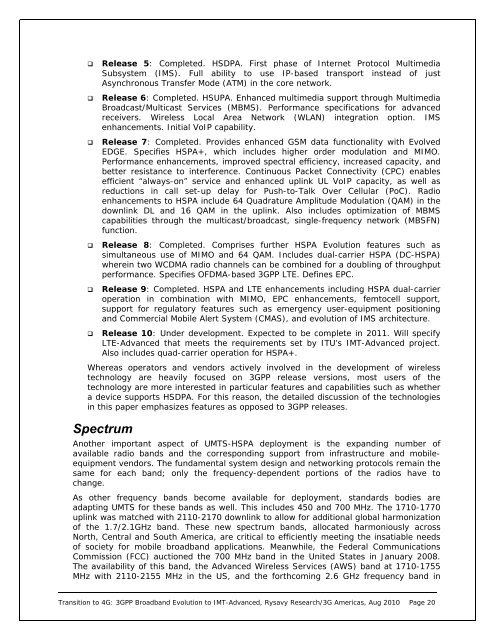3GPP Broadband Evolution to IMT-Advanced - 4G Americas
3GPP Broadband Evolution to IMT-Advanced - 4G Americas
3GPP Broadband Evolution to IMT-Advanced - 4G Americas
- No tags were found...
You also want an ePaper? Increase the reach of your titles
YUMPU automatically turns print PDFs into web optimized ePapers that Google loves.
Release 5: Completed. HSDPA. First phase of Internet Pro<strong>to</strong>col MultimediaSubsystem (IMS). Full ability <strong>to</strong> use IP-based transport instead of justAsynchronous Transfer Mode (ATM) in the core network.Release 6: Completed. HSUPA. Enhanced multimedia support through MultimediaBroadcast/Multicast Services (MBMS). Performance specifications for advancedreceivers. Wireless Local Area Network (WLAN) integration option. IMSenhancements. Initial VoIP capability.Release 7: Completed. Provides enhanced GSM data functionality with EvolvedEDGE. Specifies HSPA+, which includes higher order modulation and MIMO.Performance enhancements, improved spectral efficiency, increased capacity, andbetter resistance <strong>to</strong> interference. Continuous Packet Connectivity (CPC) enablesefficient “always-on” service and enhanced uplink UL VoIP capacity, as well asreductions in call set-up delay for Push-<strong>to</strong>-Talk Over Cellular (PoC). Radioenhancements <strong>to</strong> HSPA include 64 Quadrature Amplitude Modulation (QAM) in thedownlink DL and 16 QAM in the uplink. Also includes optimization of MBMScapabilities through the multicast/broadcast, single-frequency network (MBSFN)function.Release 8: Completed. Comprises further HSPA <strong>Evolution</strong> features such assimultaneous use of MIMO and 64 QAM. Includes dual-carrier HSPA (DC-HSPA)wherein two WCDMA radio channels can be combined for a doubling of throughputperformance. Specifies OFDMA-based <strong>3GPP</strong> LTE. Defines EPC.Release 9: Completed. HSPA and LTE enhancements including HSPA dual-carrieroperation in combination with MIMO, EPC enhancements, fem<strong>to</strong>cell support,support for regula<strong>to</strong>ry features such as emergency user-equipment positioningand Commercial Mobile Alert System (CMAS), and evolution of IMS architecture.Release 10: Under development. Expected <strong>to</strong> be complete in 2011. Will specifyLTE-<strong>Advanced</strong> that meets the requirements set by ITU’s <strong>IMT</strong>-<strong>Advanced</strong> project.Also includes quad-carrier operation for HSPA+.Whereas opera<strong>to</strong>rs and vendors actively involved in the development of wirelesstechnology are heavily focused on <strong>3GPP</strong> release versions, most users of thetechnology are more interested in particular features and capabilities such as whethera device supports HSDPA. For this reason, the detailed discussion of the technologiesin this paper emphasizes features as opposed <strong>to</strong> <strong>3GPP</strong> releases.SpectrumAnother important aspect of UMTS-HSPA deployment is the expanding number ofavailable radio bands and the corresponding support from infrastructure and mobileequipmentvendors. The fundamental system design and networking pro<strong>to</strong>cols remain thesame for each band; only the frequency-dependent portions of the radios have <strong>to</strong>change.As other frequency bands become available for deployment, standards bodies areadapting UMTS for these bands as well. This includes 450 and 700 MHz. The 1710-1770uplink was matched with 2110-2170 downlink <strong>to</strong> allow for additional global harmonizationof the 1.7/2.1GHz band. These new spectrum bands, allocated harmoniously acrossNorth, Central and South America, are critical <strong>to</strong> efficiently meeting the insatiable needsof society for mobile broadband applications. Meanwhile, the Federal CommunicationsCommission (FCC) auctioned the 700 MHz band in the United States in January 2008.The availability of this band, the <strong>Advanced</strong> Wireless Services (AWS) band at 1710-1755MHz with 2110-2155 MHz in the US, and the forthcoming 2.6 GHz frequency band inTransition <strong>to</strong> <strong>4G</strong>: <strong>3GPP</strong> <strong>Broadband</strong> <strong>Evolution</strong> <strong>to</strong> <strong>IMT</strong>-<strong>Advanced</strong>, Rysavy Research/3G <strong>Americas</strong>, Aug 2010 Page 20
















